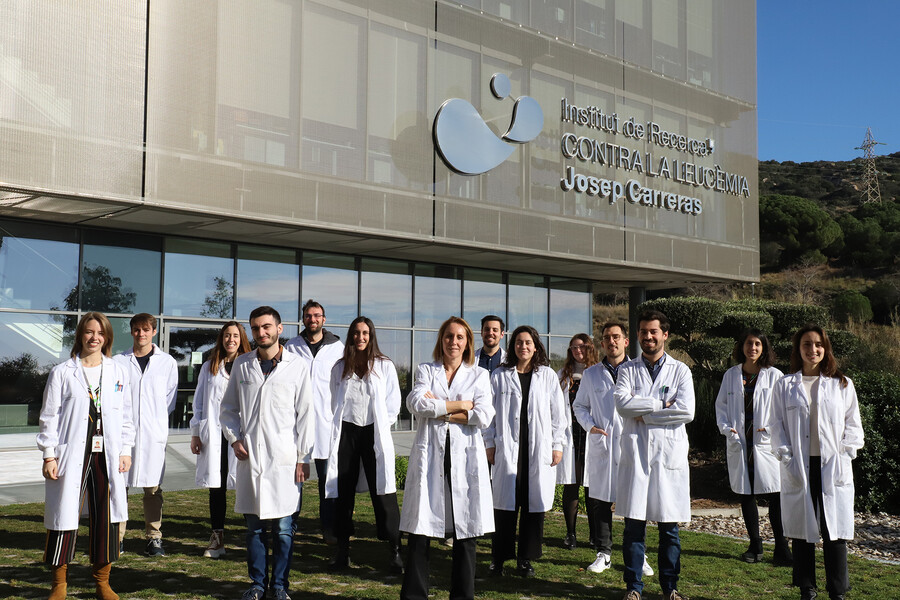
Introduction
Genetics and epigenetics of normal and malignant haematopoiesis in space and time
We are a group of passionate scientists with an insatiable thirst for learning about spatiotemporal architecture of the genome and its role in cell differentiation and function in health and disease. Our group combines cutting-edge experimental and bioinformatics approaches to understand the dynamic and specific 3D chromatin organization of normal and malignant haematopoiesis and its interaction with non-coding determinants and trans-regulatory elements. Our long-term goal is to keep making progress in the fight against cancer. We will not stop until a cure is found.
Our Research
Enhancers are critical modulators of gene transcription through physical interactions with target promoters that often locate distally in the genome. The physical proximity between enhancers and promoters is ultimately enabled and determined by the three-dimensional folding of the chromatin within the nucleus. Although enhancers can be defined through well-characterized features, predicting their target genes at distal location remains challenging due to the high complexity of studying enhancer-promoter interactions, and the large variability according to cell-type and state. This gap of knowledge is particularly problematic for understanding the molecular mechanisms associated to inherited and de novo acquired mutations and epimutations involved in common human diseases, which are all highly enriched at regulatory elements
To overcome these critical limitations, we have recently developed a low input cost-effective method to robustly map and compare promoter interactomes at high resolution in rare cell populations previously unmeasurable. This new method broadens the capacity for studying organism developments, in vivo cell commitment, cellular response to a wide range of external stimulus and disease pathogenesis.
Our Goals
Our lab’s main research goals, which are motivated by this gap in the knowledge, are as follows:
- To define the cell type-specific 3D chromatin organization in human haematopoietic cells. Human haematopoietic differentiation dogma is currently a subject of debate. All blood cells originate from haematopoietic stem cells (HSCs), which represent the apex of a differentiation cascade of progenitor cell types that gives rise to billions of new differentiated cells every day. HSC differentiation, which progresses through stepwise hierarchical restriction of lineage potential, has been extensively characterized at epigenetic, transcriptional and functional levels. However, the contribution of genome architecture in regulating haematopoiesis remains unexplored.
Motivated by this gap of knowledge, we aim to investigate whether the dynamic changes in chromatin interactions between gene promoters and regulatory elements can shape transcription decisions controlling haematopoiesis and blood cell function. These insights can lead to improvements in regenerative medicine strategies, especially bone marrow transplants, which represent one of the most promising approaches to treating many diseases, including blood cancer.
To identify the altered DNA topology in blood cancer. The genome architecture plays a key role in genome expression regulation and DNA repair. Chromatin interactions are therefore crucial for cellular health, and errors in these interactions can give rise to the development of a broad range of diseases, including blood cancer. Research into these altered 3D structures can help improve knowledge of the tumour process, thereby providing new opportunities for the development of novel treatment approaches and diagnostic strategies.
To prioritize new candidate genes and pathways related to leukemias and lymphomas. During the previous years, thousands of determinants associated with blood cancer have been identified. However, most of them remains unexplored because of these target non-coding regions, frequently enhancers and other distal regulatory elements. Genetic and epigenetic alterations at distal regulatory elements have the potential to alter the regulatory properties and ultimately lead to quantitative changes in expression of distal target genes with pathological outcome. However, in most of the cases, the target genes area unknown. By studying the physical interactions between gene promoters and regulatory elements, we connect blood cancer cis and trans determinants to putative target genes, thereby prioritizing new candidate genes and pathways and offering an insight into the genomic regulatory mechanisms underlying cancer. In addition, the interpretation of the non-coding regions altered in disease will also help us improve patient outcome prediction and allow us to design better, more personalized treatments.
Our Challenges
Through our research, we hope to answer the following questions:
- Can the dynamic changes in chromatin interactions shape the transcription decisions controlling haematopoiesis and blood cell function?
- Which are the blood cell-type specific key factors orchestrating genome architecture?
- How does the altered genome architecture drive malignant transformation?
- What is the role of non-coding determinants in cancer predisposition, development and relapse?
Why our research matters
Blood cancers, including leukemias and lymphomas, are a leading cause of mortality in paediatric and adult patients worldwide. We aim to provided fundamental understanding of blood cancer development and relapse to identify new biomarkers and novel therapeutic targets to ultimately improve patient survival.
Team
Junior Group Leader

Postdoctoral Investigator

Postdoctoral Investigator

Postdoctoral Investigator

Postdoctoral Investigator
Postdoctoral Investigator
PhD Student

PhD Student

PhD Student

PhD Student
.jpg?locale=en)
PhD Student

PhD Student

PhD Student

Research Assistant

Medium Lab Technician

Lab Assistant Technician
Selected Publications
Current Grants
Agència de gestió d'ajuts universitaris i de recerca
3DNAViewer 3DNAViewer - Validation of a transferable AI solution for automated analysis of 3D-DNA-FISH images in research environments
Ministerio de ciencia, innovación y universidades
2ª Red de Regulación Genómica
European commission
SCIE-PANC Stromal Compartment and Immune Epigenome spatial networks to counter therapy evasion in PANcreatic Cancer
Ministerio de ciencia e innovación
3DBGENOME Descifrando el papel y la regulación de la arquitectura del genoma espacio-temporal en en la linfomagénesis de células B

Fundació internacional josep carreras
Study of the role of 3D Chromatin Organization in Gene regulation and B Cell Differentiation, its role as protector againts oncogenic off-target AID damage and in Diffuse Large B Cell lymphoma
Fundació "la caixa"
BALL RELAPSE Deciphering relapse in B-cell acute lymphoblastic leukemia

Fundación bbva
Decoding how silencers orchestrate normal and malignant cell differentiation
Deutsche josé carreras leukämie stiftung
Deciphering the Oncogenic Role of the PRC1 Complexes Through Integration of Functional and Spatial Genomics in Diffuse Large B-cell Lymphoma

European hematology association
noncoDLBCL Decoding the Role of the Noncoding Genome in Diffuse Large B-Cell Lymphoma
Fundación cris contra el cáncer
DISTAL-REGULOPATHY Addressing leukemia as a distal-regulopathy to improve patient survival
Blood cancer uk
Investigating the consequences of CEBP dysregulation in acute lymphoblastic leukaemia.
Fundación científica de la asociación española contra el cáncer
Shh-ALL Dissecting the role of Silencers in Acute Lymphoblastic Leukaemia to improve its clinical management
Agència de gestió d'ajuts universitaris i de recerca
Approaching susceptibility to B-cell malignancies from a single-cell perspective to identify new therapeutic targeten pacientes de bajo riesgo a la evaluación funcional de variantes de significado incierto
Instituto de salud carlos iii

Ministerio de ciencia e innovación
Descifrando el papel y la regulacion de la arquitectura del genoma espacio temporal en la linfomagenesis de celulas B

Fundación científica de la asociación española contra el cáncer
Deciphering the role and regulation of spatial-temporal genome architecture in B cell lymphomagenesis

Ministerio de ciencia, innovación y universidades